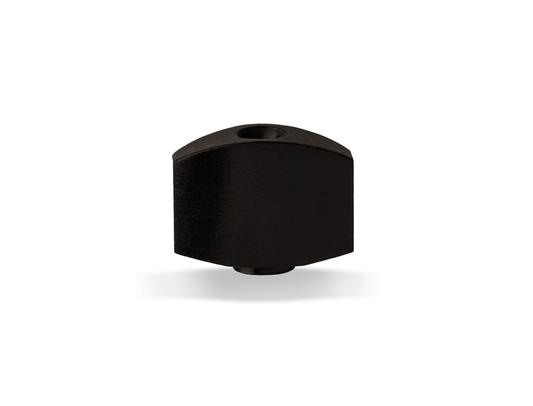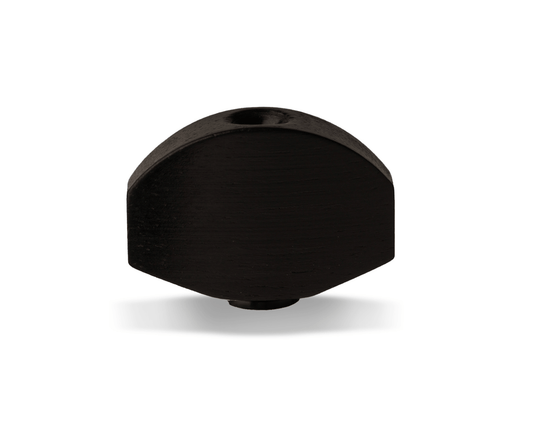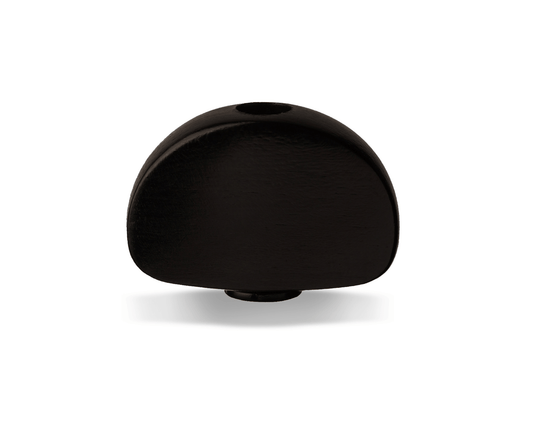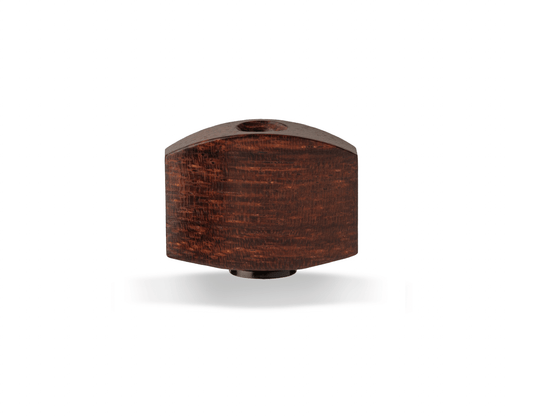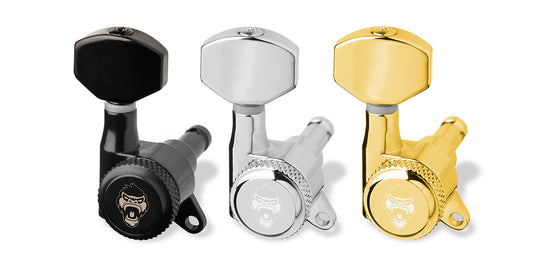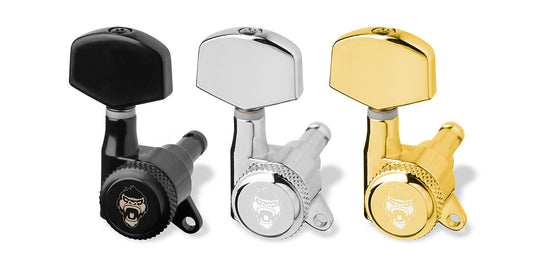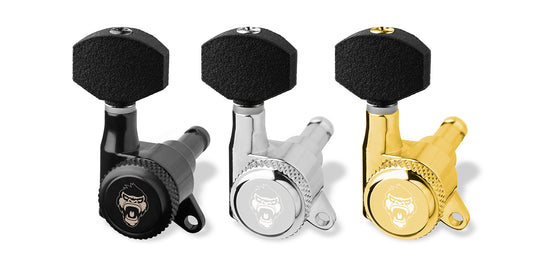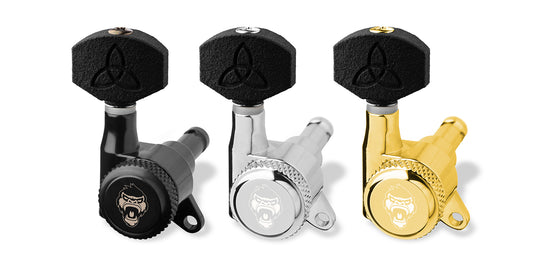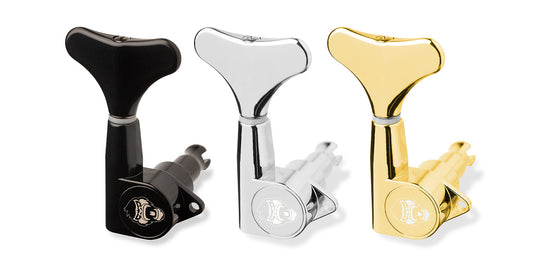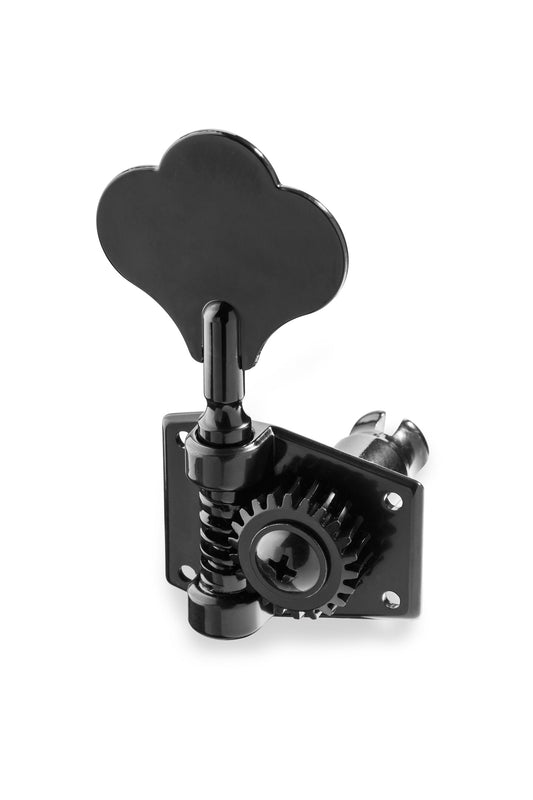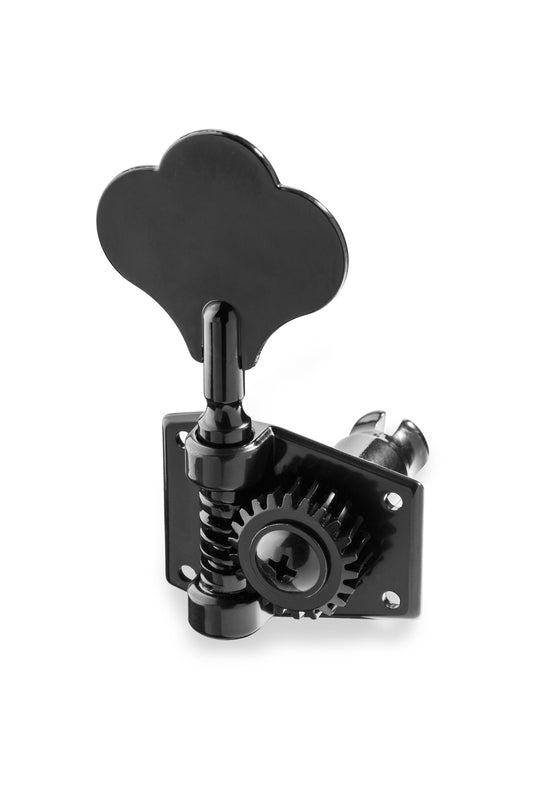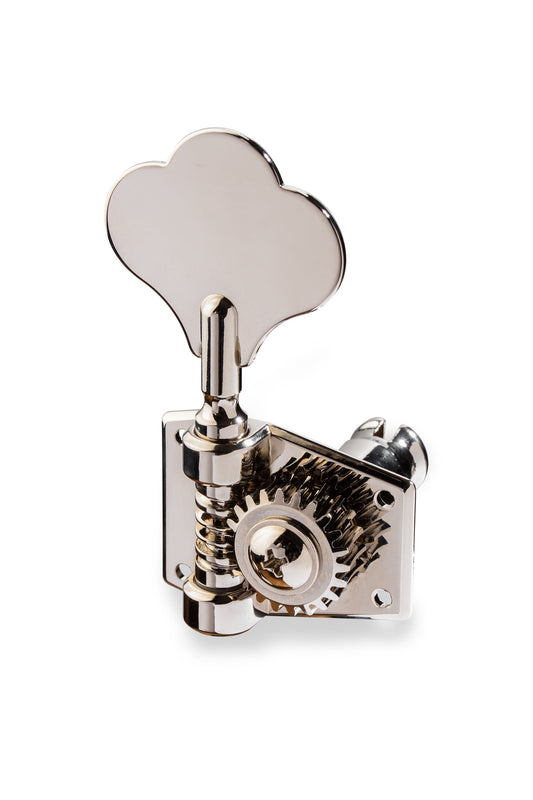How do I find the right bass machine heads for my bass?
1. Choose the right type of bass machine heads
First of all, you have to think about what type of bass mechanics you want for your bass. There are a variety of different bass mechanics on the market. We have therefore created a separate page for this topic, which you can find here .
If you are clear about the type of bass mechanics, move on to the next points to find the right variant for the selected type of bass mechanics that fits your bass.
2. Determine the hole diameter for the adjusting axis/post of the bass tuners on the headstock of the bass
In order for the bass mechanics to fit through the holes on the headstock of your bass, it is of course important to know how big these holes are and what diameter the bass mechanics have.
Most modern basses have 14 mm holes for the bass tuners. Many vintage basses have holes between 17 mm and 18 mm for the bass tuners. Special dimensions can also be found on some basses, but these are so extremely rare that bass tuners are often not offered for them.
Our Silverback Vintage Bass Tuners Prejazz have an 18 mm diameter. Here you can find our Prejazz Vintage Bass tuners .
Our Gorilla Bass Tuners all have a 14 mm diameter for modern basses. Here you can find our Gorilla Bass mechanics.
To find out the hole diameter for the bass tuners in your headstock, you can easily measure the holes or simply measure the bass tuners that were previously installed.
3. Determine the mounting method for the bass tuners on the headstock of the bass
There are different ways to attach bass tuners to the headstock of bass guitars. A bass mechanic is always attached to two points on the bass headstock. A distinction is made between the attachment of the bass mechanics on the front of the guitar headstock to the adjusting axis / post of the guitar mechanics and the attachment on the back of the guitar headstock to the housing of the guitar mechanics.
3.1 Attaching the bass mechanics from the front: to the adjusting axis/post
3.1.1 Fastening the bass mechanics with screw sockets
Bass tuners with screw sockets are usually found on bass guitars. The screw sockets are screwed from the front into the headstock of your bass guitar directly into the bass mechanics, which are mounted from the back of the headstock. The bass mechanic screw sockets hold the bass mechanics firmly on the headstock and protect them from falling out. The radial securing of the bass mechanics, i.e. securing them against twisting, is done either by the screws or pins on the housing of the bass mechanics (see 3.2 Fastening the bass mechanics from the rear)
We also sell our screw jacks for bass tuners separately. Click here to access our screw sockets.
3.1.2 Fastening the bass mechanics with press-in sleeves
Fastening with press-in sleeves is mostly used for vintage bass tuners. However, one speaks here of a guide rather than a fastening, since the press-in sleeve does not hold the bass mechanism in place, but rather the actuating axis/post of the bass mechanism runs in the press-in sleeve.
In this variant, the bass mechanism is always attached to the housing of the bass mechanism with two or four screws and secures the bass mechanism against both radial twisting and against falling out (see point 3.2.1.2 Fastening with screws).
We also sell our press-in sleeves for bass tuners separately. Click here to access our press-in sleeves.
3.2 Attaching the bass mechanics from the rear: to the housing
3.2.1 Screw fastening
Fastening the bass machine heads to the headstock of the bass guitar using screws is the most common method. A distinction is made between fastening the guitar mechanics with one, two or four screws.
We also sell our screws for bass tuners separately. Click here to access our screws.
When screwing bass tuners, pay attention to how many screws are used and how the screw holes on the bass tuners are designed.
3.2.1.1 Fastening with a screw
Fastening the bass mechanics with a screw is usually found on modern bass mechanics. A 90 degree screw bracket is usually used here, as it offers a compact design and can be easily installed even on small headstocks.
We also offer our Gorilla Bass tuners with a 90 degree screw lug. Here you can find our Gorilla Bass mechanics.
3.2.1.2 Fastening with two or four screws
Fastening bass tuners with two or four screws is usually found on vintage bass tuners. There are screw holes on the left and/or right of the guitar mechanics housing. With some bass mechanics these are also offset.
Our Silverback Vintage Bass Tuners Prejazz are offered with four screws. Here you can find our Prejazz Vintage bass tuners .
When screwing bass mechanics into place, pay attention to what the hole pattern of the bass mechanic looks like so that it fits the bass guitar. If the hole pattern doesn't fit, you can of course simply drill new holes in the headstock.
3.2.2 Pin fastening
The pin fastening of bass tuners is not as widespread as the screw fastening. When attaching the pin, the housing of the bass mechanism is locked in the headstock of the bass guitar using one or two pins attached to the back of the housing. So we differentiate:
- 1 pin variant
- 2 pin variant
The pin fastening of bass mechanics is always combined with fastening from the front with screw sleeves (see point 3.1.1), as this type of fastening protects the bass mechanics from falling off. The sole purpose of the pin attachment is to ensure that the bass mechanism cannot twist or slip radially.
When attaching pins to bass mechanics, it is important to pay attention to how many pins are used and what diameters and distances the pins have so that they fit the bass guitar. If the pins don't fit, you can of course close the old pin holes in the headstock of the bass guitar and drill new pin holes. This is of course much more complex than screw fastenings.
Our guitar mechanics wooden buttons
-
Small German Ebony Guitar Mechanics Grand Piano / Tuner Buttons / Knobs
Normal price From €27,90Normal pricebasic price / pro -
Big German Ebony Guitar Mechanics Tuner Buttons / Wings / Knobs
Normal price From €27,90Normal pricebasic price / pro -
Big Vintage Kidney Bean Ebony Guitar Mechanics Tuner Buttons / Wings / Knobs
Normal price From €27,90Normal pricebasic price / pro -
Small German Tamarind Wood Guitar Mechanics Grand Piano / Tuner Buttons / Buttons
Normal price From €27,90Normal pricebasic price / pro
Our Monkey Locks - Locking Tuners
-
Single - Monkey Lock - Locking Tuner - Guitar Clamp Mechanism - Small German Metal Button
Normal price From €10,80Normal pricebasic price / pro -
Single - Monkey Lock - Locking Tuner - Guitar Clamp Mechanism - Big German Metal Button
Normal price From €11,70Normal pricebasic price / pro -
Single - Monkey Lock - Locking Tuner - Guitar Clamp Mechanism - Megalight Monkey Grip Button - Small German
Normal price From €14,20Normal pricebasic price / pro -
Single - Monkey Lock - Locking Tuner - Guitar Clamp Mechanism - Celtic Megalight Monkey Grip Button - Small German
Normal price From €14,20Normal pricebasic price / pro
Our bass mechanics
-
Single Bass Mechanics - Slinky Metal Button
Normal price From €8,90Normal pricebasic price / pro -
Single (1 L) Silverback Vintage Bass Tuner Prejazz in Black - Clover Leaf Buttons
Normal price €12,50Normal pricebasic price / pro -
Single (1 R) Silverback Vintage Bass Tuner Prejazz in Black - Clover Leaf Buttons
Normal price €12,50Normal pricebasic price / pro -
Single (1 L) - Silverback Vintage Bass Mechanics Prejazz in Nickel - Clover Leaf Buttons
Normal price €12,50Normal pricebasic price / pro
Image banner
Give customers details about the banner image(s) or content on the template.

